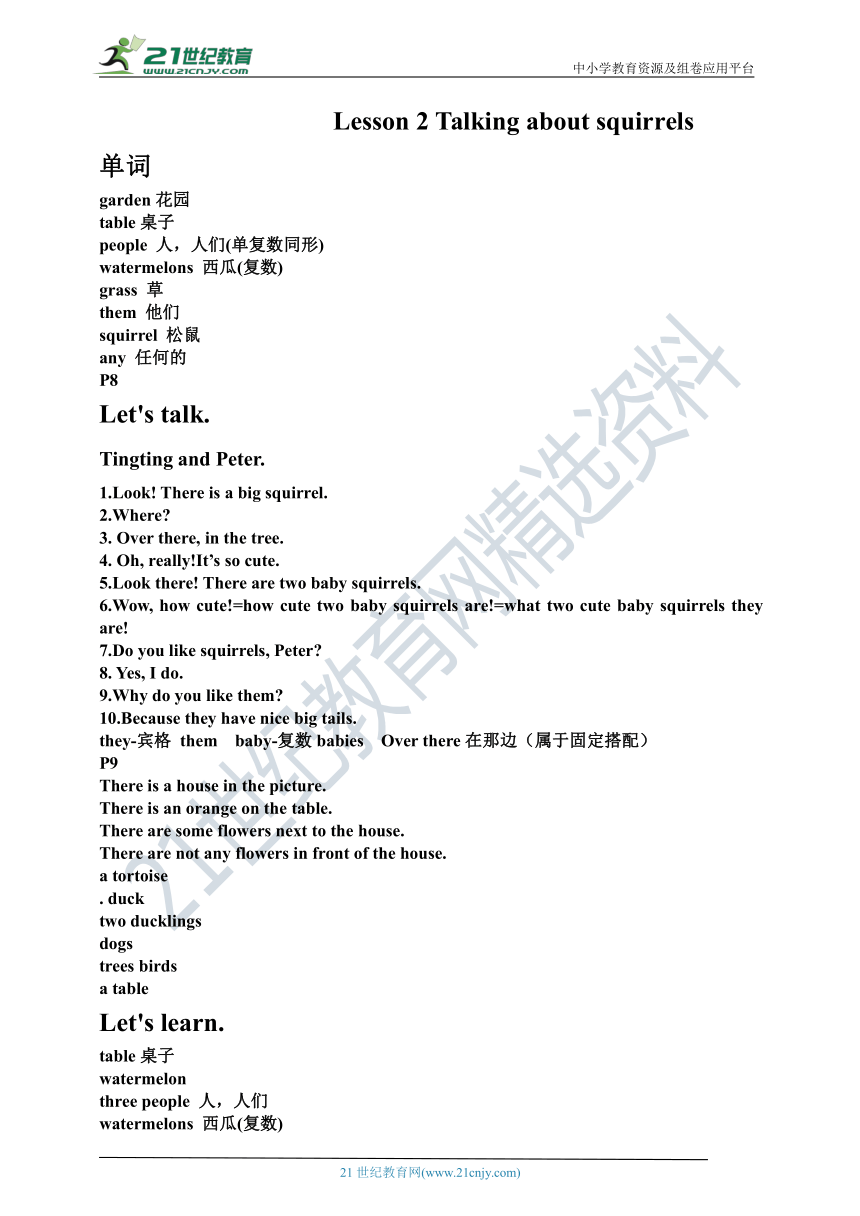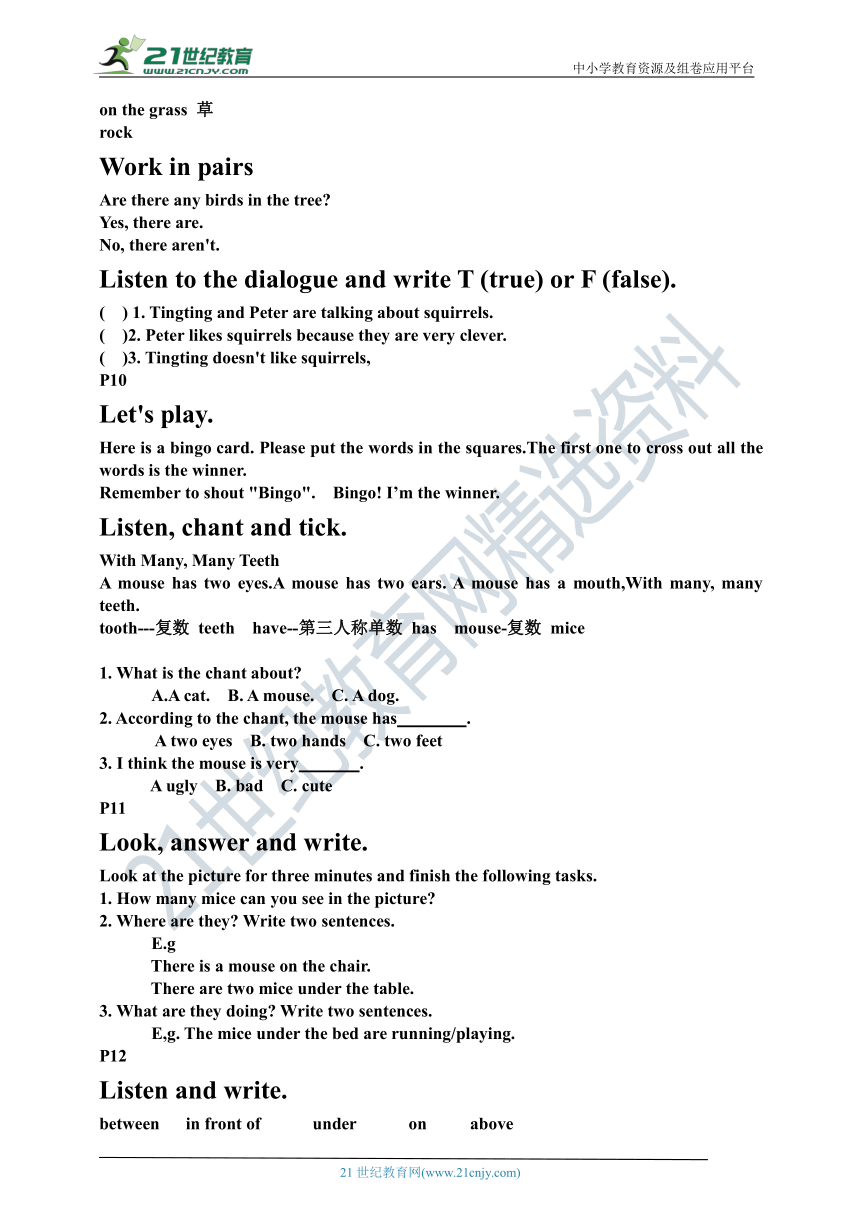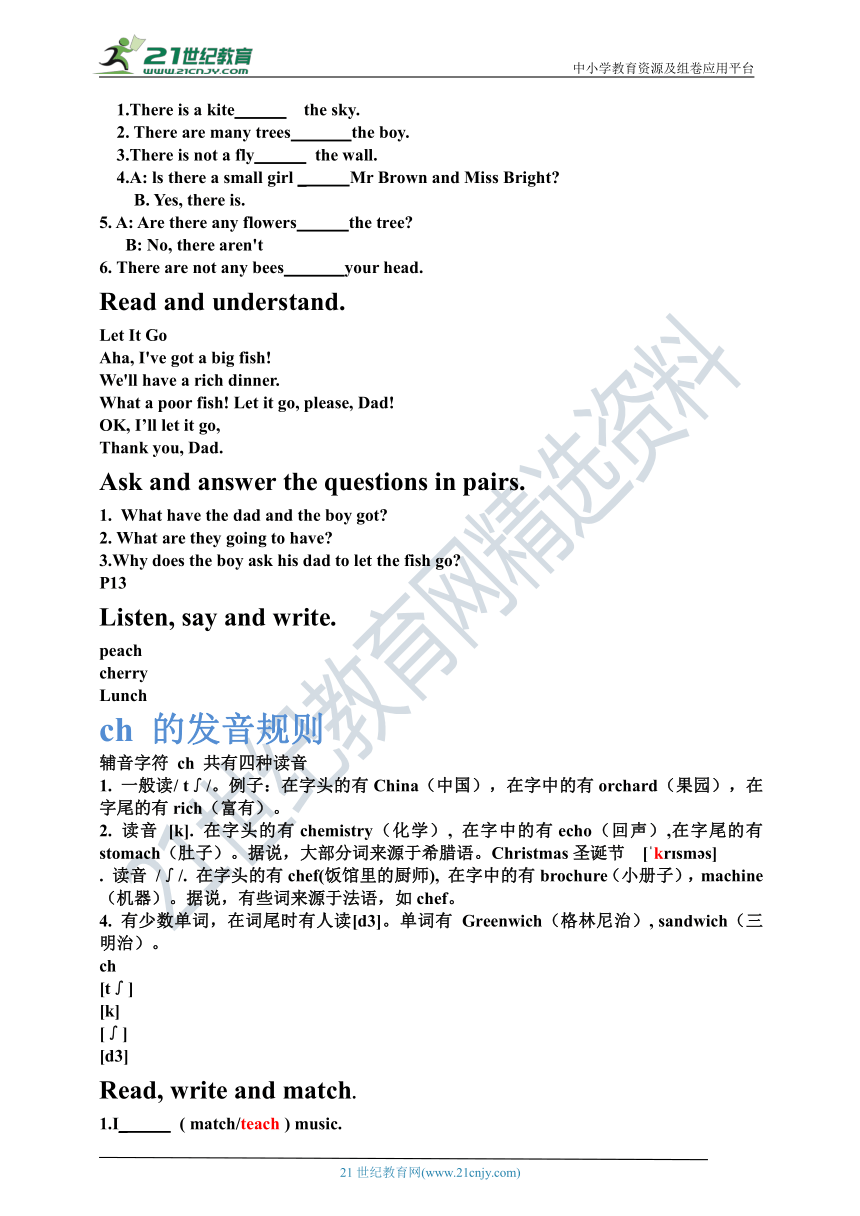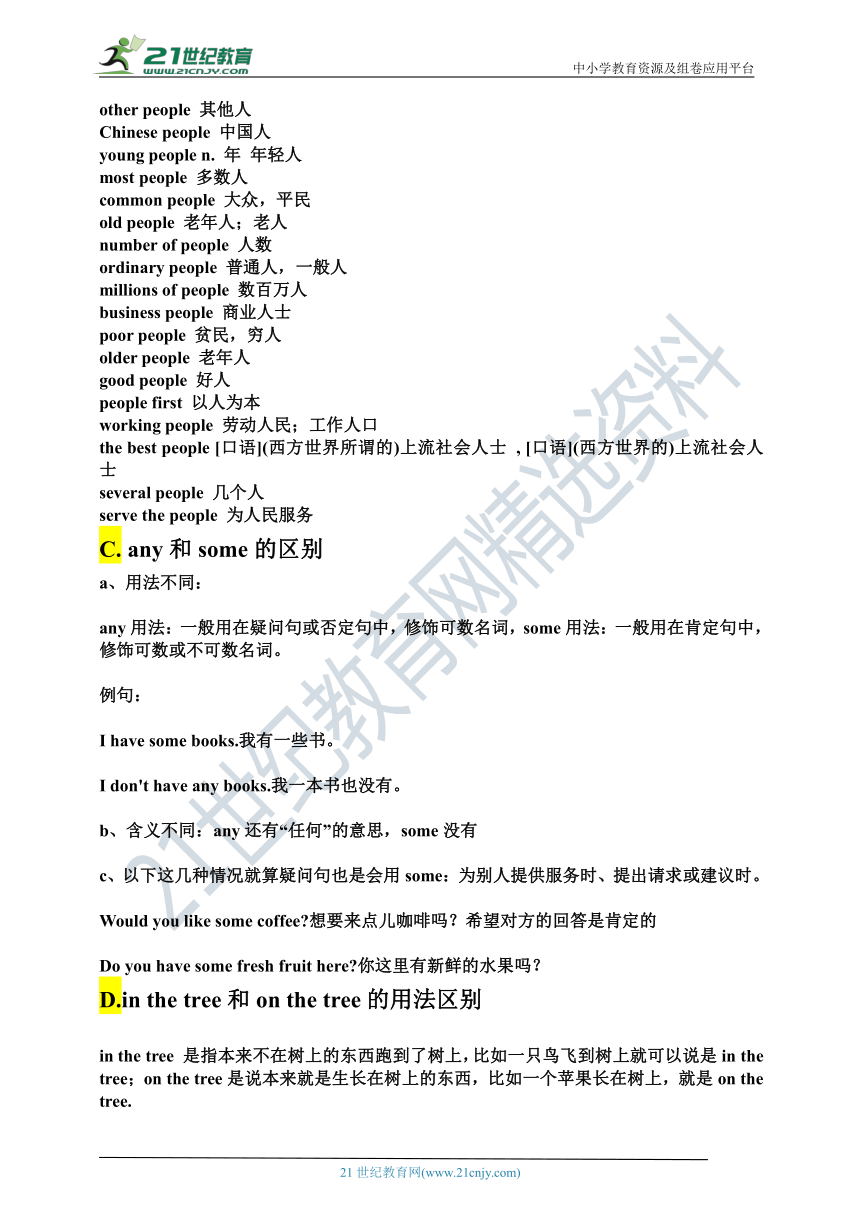Unit 1 We love Nature Lesson 2 知识汇总(单词+句型+语法)
文档属性
| 名称 | Unit 1 We love Nature Lesson 2 知识汇总(单词+句型+语法) |

|
|
| 格式 | zip | ||
| 文件大小 | 216.2KB | ||
| 资源类型 | 试卷 | ||
| 版本资源 | 川教版 | ||
| 科目 | 英语 | ||
| 更新时间 | 2020-02-01 11:14:07 | ||
图片预览





文档简介
中小学教育资源及组卷应用平台
Lesson 2 Talking about squirrels
单词
garden花园
table桌子
people??人,人们(单复数同形)
watermelons??西瓜(复数)
grass??草
them??他们
squirrel??松鼠
any??任何的
P8
Let's talk.
Tingting and Peter.
1.Look! There is a big squirrel.
2.Where?
3. Over there, in the tree.
4. Oh, really!It’s so cute.
5.Look there! There are two baby squirrels.
6.Wow, how cute!=how cute two baby squirrels are!=what two cute baby squirrels they are!
7.Do you like squirrels, Peter?
8. Yes, I do.
9.Why do you like them?
10.Because they have nice big tails.
they-宾格 them baby-复数babies Over there在那边(属于固定搭配)
P9
There is a house in the picture.
There is an orange on the table.
There are some flowers next to the house.
There are not any flowers in front of the house.
a tortoise
. duck
two ducklings
dogs
trees birds
a table
Let's learn.
table桌子
watermelon
three people??人,人们
watermelons??西瓜(复数)
on the grass??草
rock
Work in pairs
Are there any birds in the tree?
Yes, there are.
No, there aren't.
Listen to the dialogue and write T (true) or F (false).
( ) 1. Tingting and Peter are talking about squirrels.
( )2. Peter likes squirrels because they are very clever.
( )3. Tingting doesn't like squirrels,
P10
Let's play.
Here is a bingo card. Please put the words in the squares.The first one to cross out all the words is the winner.
Remember to shout "Bingo". Bingo! I’m the winner.
Listen, chant and tick.
With Many, Many Teeth
A mouse has two eyes.A mouse has two ears. A mouse has a mouth,With many, many teeth.
tooth---复数 teeth have--第三人称单数 has mouse-复数 mice
1. What is the chant about?
A.A cat. B. A mouse. C. A dog.
2. According to the chant, the mouse has .
A two eyes B. two hands C. two feet
3. I think the mouse is very .
A ugly B. bad C. cute
P11
Look, answer and write.
Look at the picture for three minutes and finish the following tasks.
1. How many mice can you see in the picture?
2. Where are they? Write two sentences.
E.g
There is a mouse on the chair.
There are two mice under the table.
3. What are they doing? Write two sentences.
E,g. The mice under the bed are running/playing.
P12
Listen and write.
between in front of under on above
1.There is a kite the sky.
2. There are many trees the boy.
3.There is not a fly the wall.
4.A: ls there a small girl _ Mr Brown and Miss Bright?
B. Yes, there is.
5. A: Are there any flowers the tree?
B: No, there aren't
6. There are not any bees your head.
Read and understand.
Let It Go
Aha, I've got a big fish!
We'll have a rich dinner.
What a poor fish! Let it go, please, Dad!
OK, I’ll let it go,
Thank you, Dad.
Ask and answer the questions in pairs.
What have the dad and the boy got?
2. What are they going to have?
3.Why does the boy ask his dad to let the fish go?
P13
Listen, say and write.
peach
cherry
Lunch
ch 的发音规则
辅音字符 ch 共有四种读音
1. 一般读/ t∫/。例子:在字头的有China(中国),在字中的有orchard(果园),在字尾的有rich(富有)。
2. 读音 [k]. 在字头的有chemistry(化学), 在字中的有echo(回声),在字尾的有 stomach(肚子)。据说,大部分词来源于希腊语。Christmas圣诞节 [?kr?sm?s]
. 读音 /∫/. 在字头的有chef(饭馆里的厨师), 在字中的有brochure(小册子),machine(机器)。据说,有些词来源于法语,如chef。
4. 有少数单词,在词尾时有人读[d3]。单词有 Greenwich(格林尼治), sandwich(三明治)。
ch
[t∫]
[k]
[∫]
[d3]
Read, write and match.
1.I_ ( match/teach ) music.
2. I love _ (China/cherry)!
3. Please _ __(teach/catch) the fat rat.
4. They have (lunch/peach) at home.
Read, correct and write.
Holidays begin with capital letter.
children's day-----Children's Day
1, Happy women's day, Mum!
It's teachers' day.
June 1st is .
4. December 25th is .
语法一:
A.不可数名词是指不能以数目来计算,不可以分成个体的概念、状态、品质、感情或表示物质材料的东西;它一般没有复数形式,只有单数形式,它的前面不能用不定冠词a / an ,若要表示它的个体意义时,一般要与一个名词短语连用,相当于中文里的【数词+(量词)+ 名词】,其中的量词意义依与具体的名词搭配而定。但当不可数名词表示“一种、一场、一次”、“一番”、某种情绪的不可数名词用来指引起这种情绪的事情或某件产品、作品时,它的前面也能直接用不定冠词a / an。不可数名词 uncountable noun 常用缩写为un。当不可数名词使用复数形式时,其意思会有变。如glass玻璃,glasses眼镜。或有泛指所有同类事物,如fruit水果,fruits(各种)水果。用法意思需要根据实际来看。
B. people,英文单词,名词、动词,作名词时译为“人;人类;民族;公民”,作动词时译为“居住于;使住满人”。people是集体名词,是可数名词。单复数同行,不加s,people 是单复数同形:
集体名词,以单数形式出现,但实为复数. 不能说 a people
普通名词所表示的人或事物是可以按个数计算的,这类名词叫可数名词。可数名词分为个体名词(表示某类人或事物中的个体,如worker, farmer, desk, factory等)和集体名词(表示作为一个整体来看的一群人或一些事物,如people, family 等)。如果普通名词所表示的事物是不能按个数来计算的,这类名词就叫不可数名词。不可数名词分为物质名词(表示无法分为个体的物质,如meat, rice, water, milk, orange 等)和抽象名词(表示动作、状态、情况、品质等抽象概念,如work, homework, time, health, friendship等)。
many people 许多人;很多人;好多人
some people 有些人;有人;一些人
other people 其他人
Chinese people 中国人
young people n. 年 年轻人
most people 多数人
common people 大众,平民
old people 老年人;老人
number of people 人数
ordinary people 普通人,一般人
millions of people 数百万人
business people 商业人士
poor people 贫民,穷人
older people 老年人
good people 好人
people first 以人为本
working people 劳动人民;工作人口
the best people [口语](西方世界所谓的)上流社会人士 , [口语](西方世界的)上流社会人士
several people 几个人
serve the people 为人民服务
C. any和some的区别
a、用法不同:
any用法:一般用在疑问句或否定句中,修饰可数名词,some用法:一般用在肯定句中,修饰可数或不可数名词。
例句:
I have some books.我有一些书。
I don't have any books.我一本书也没有。
b、含义不同:any还有“任何”的意思,some没有
c、以下这几种情况就算疑问句也是会用some:为别人提供服务时、提出请求或建议时。
Would you like some coffee?想要来点儿咖啡吗?希望对方的回答是肯定的
Do you have some fresh fruit here?你这里有新鲜的水果吗?
D.in the tree和on the tree的用法区别
in the tree 是指本来不在树上的东西跑到了树上,比如一只鸟飞到树上就可以说是in the tree;on the tree是说本来就是生长在树上的东西,比如一个苹果长在树上,就是on the tree.
E.there be句型的疑问句
A.There be 句型的一般疑问句是将be 放在there 之前,回答时用yes或no,后接简单答语。句式:Be(Is/Are)+there+某物/某人+地点/时间?
如:Is there a cake on the table? 桌子上有块蛋糕吗?
Yes,there is. / No,there isn’t. 是,有。/ 不,没有。
Will there be a party tonight? 今晚有聚会吗?
Yes,there will./ No, there won’t 是的,有。/ 不,没有。
Have there been any letters from your mother lately? 近日你妈妈有信来吗?
Yes,there have./ No, there haven’t.
是,有的。/ 不,没有。
B.There be 句型的特殊疑问句主要有how many和how much做引导词两种情况。句式:特殊疑问词+ be(is/are)+there+其它?
如:How many students are there in your school? 你们学校有多少学生?
How much money is there in your pocket? 你口袋里有多少钱?
语法二:名词复数
一个名词如果表示一个或一样东西,它取单数形式,如pen,dog,tree,fact,church,kiss.如果表示两个或更多的这类东西,则需要用名词复数形式,如pens,dogs,trees,facts,churches,kisses.构成名词复数,大多数在单数形式后加-s或-es,有下面情况:
规则变化
1) 一般情况加s
例如:map-maps boy-boys girl-girls pen-pens bag-bags car-cars
(清辅音后读/s/,浊辅音和元音后读/z/,/s/、/z/、/d?/等音后发/iz/)
2) 以s, sh, ch, x结尾加es,读/iz/。
例如:bus-buses watch-watches box-boxes brush-brushes
3) 以辅音字母+y结尾,变y为i再加es,读/iz/。
例如:baby---babies city-cities country-countries
4) 以y结尾的专有名词或元音字母+y结尾的名词变复数时,直接加s,读/z/
monkey---monkeys holiday---holidays Mary---Marys(专有名词)
5) 以辅音+o结尾无生命的名词,直接加s,读/z/.
例如:piano-pianos photo-photos alto-altos soprano-sopranos quarto-quartos(四开本)
以辅音+o结尾有生命(包括动植物)的名词,加es,读/z/.
例如:hero-heroes tomato-tomatoes potato-potatoes
6)有些以f或fe结尾的,把f或fe变ve加s,例如:leaf-leaves shelf-shelves
不规则变化
1) child---children foot---feet tooth---teeth
mouse---mice man---men woman---women
注意:由一个词加 man 或 woman构成的合成词,其复数形式也是 -men 和-women,
如an Englishman,two Englishmen。
但German不是合成词,故复数形式为Germans;Bowman是姓,其复数是the Bowmans。
2)单复同形,
如:deer,sheep,fish,Chinese,Japanese ,li,jin,yuan,two li,three mu,four jin等。
但除人民币的元、角、分外,美元、英镑、法郎等都有复数形式。
如:a dollar, two dollars; a meter, two meters。
表示一群人或一些物的名词叫集体(或集合)名词。为便于弄清其特点,我们不妨把它们分为表示无生命的物的“类”和表示主要是由人(有少数是低等动物)构成的“群”的集体名词。
⑴表示“类”的集体名词,常见的有
clothing
furniture
baggage/luggage
jewelry
traffic
information
machinery
merchandise
produce
scenery
它们指同一类的许多东西,其用法与不可数名词相当:
①形式上总是单数,没有复数形式,作主语时,谓语用单数。
如:
The old machinery is out of date.
这些旧机器过时了。
②不可直接与a(n)或数词连用。表数量时用many,much,little,some,a piece of,an article of,a set of等。
如:
Each room has five pieces of furniture.
每个房间有五件家具。
③若需用代词,用单数代词。
如:
Do you want to see my jewelry?It is in the box.
你想看我的珠宝吗?它在我的箱子里。
⑵表示“群”的集体名词常见的有
(Ⅰ)
people
police
cattle
poultry (家禽)
vermin (害虫,寄生虫)
clergy (牧师,神职人员)
militia(民兵组织)
crew 队,全体人员,全体成员
(Ⅱ)
family
class
team
government
crowd
committee
jury
party
firm
couple
board
语法三:
a.look用作不及物动词时主要作“看”“观望”解,常与介词at连用。
如:He looked at the baby with a smile.
他笑着看着这个婴儿。
如果后面跟副词就省略介词at。如:Look there!看那里 Look here!看这里
b.look用作及物动词时主要作“注视”解,引申还可作“留心”“注意”“期望”解,其后可接动词不定式、疑问词引导的从句作宾语。可用于祈使句。
Look! There is a big squirrel.
语法四:
(一)感叹句的定义
感叹句是用来表达说话者说话时的惊异、喜悦、愤怒、气愤等思想感情的句子。其结构常由感叹词“What(How)+感叹的部分+主语+谓语!”构成。
(二)感叹句的结构
常见句型:
1、由感叹词what引导的感叹句。
what修饰名词或名词短语,有以下两种形式:
●What+a(an)+(形容词)+单数可数名词+主语+谓语!
例句:What an apple this is!
●What+(形容词)+可数名词复数或不可数名词+主语+谓语!
例句:What kind women they are!
例1)What a nice watch(it is)!
(它是)多么漂亮的手表啊!
2)What kind children they are!
他们是多么好的孩子啊!
3)What delicious food that is!
那是多么美味的食物啊!
注:(1)单数可数名词前要加冠词a/an,如例1)
复数可数名词或不可数名词前则不加冠词,如例2),例3)
2、由How引导的感叹句。
how用来修饰形容词、副词或动词。其结构是:How+形容词(adj.)/副词(adv.)+主语(s.)+谓语动词(v.)!
注意:当how修饰动词时,动词不跟着感叹词提到主语之前。
例4)How interesting the stories are!
那些故事多么有趣呀!
例5)How hard the workers are working!
工人们干得多么努力啊!
例6)How delicious the food is!
那食物是多么可口啊!
(三)陈述句变感叹句可用“一断、二变、三换位”的方法,简便易学,便于掌握。
1、“一断”。就是先把陈述句从谓语动词后面用“‖”号分断为前后两部分。
例7)It is‖a very nice watch .
例8)The stories are‖very interesting .
2、“二变”。就是把第二部分变为由What或How引导的短语。这样,例7)中的后一部分是个名词短语,结果就变成了What a nice watch :
It is‖what a nice watch .
例8)中的后一部分是个形容词,就变成了How interesting:
The stories are‖how interesting .
3、“三换位”。就是已变好的后一部分和前一部分的主谓语交换位置。这样,就变成了感叹句:
What a nice watch it is!
How interesting the stories are!
what与how引导的感叹句,一般情况下可以相互转换,转换后意义不变。
例句:What an interesting story it is!==How interesting the story is!
(四)由于感叹句是表达一个人的强烈情感,如兴奋、愤怒、挽惜等,所以使用者可根据情感的变化,使用不同的句式。除What一句型、How一句型外,还可以用陈述句、疑问句等句式;也可以用一个词组、甚至一个词来表达自己的感情。下面的例句或供初学者参考。
例9)The fish and the coral reefs are beautiful!
(=How beautiful the fish and the coral reefs are!)
那些鱼和珊瑚礁很美!
例10)That sounds really cool!
(=How cool that sounds!)
那听起来真酷!
例11)The waves at Makaha are terrific!
(How terrific the waves at Makaha!)
语法五:
英语中,多个形容词同时修饰一个名词,需要遵循下列顺序:
限定词+描绘+形状+新旧+颜色+产地+材料+名词。
具体解说如下:
限定词包括:冠词,数词,指示代词,形容词性物质代词,名词所有格等。如: my ,Tom's ,this ,that ,the 等。
描绘性形容词:如:beautiful,interesting,expensive,等感觉器官上的描述性形容词
表示形状的词:如:small,big,short,round,square,等
表示新旧的词:如:old ,new
表示产地的词:也就是产自国家,或者地区的词。如:city,Chinese,local等
表示材料,物质本质的词,如:wood,stone.gold 等。
1.举例:一个蓝色的塑料小盒子。 a (限定词)small(大小) blue(颜色) plastic(材质)+ box.
2.我姐姐的有一个有趣的,国产的竹子小花瓶
my sisiter's(限定词) interesting(描绘) little (大小)Chinese(产地) bamboo(材质)+ vase.
3.两张新的,贵重的,黄颜色的,国产的小圆形塑料桌
two (数词)expensive(描绘) small (大小)round(形状) new(新旧) yellow(颜色) Chinese (产地)plastic(质地) +tables
窍门来了:
按照:限定词+描绘+形状+新旧+颜色+来源+材料+名词 这个顺序,编一个顺口溜:
县 官 行 令 杀 国 才+名词
县,跟限定词的限是谐音;官,指感官描述的形容词;行,是形状大小的“形”的谐音;令是跟年龄的龄谐音,指新旧;杀,跟颜色的“色”谐音;国指国家,也就是产地;才跟材料的“材”谐音。
语法六:大写2
月份和星期几的首字母要大写。
如:Today is the fourth Thursday of November.
节日名称的第一个实词首字母大写。
如:The Spring Festival is the most important holidays in China.
举例说明,He works on Monday.(星期一他要上班),She was born on April.(她在四月出生),Sunday is Father’s Day.(星期天是父亲节)。这类词出现句中的任何位置都需要使用大写字母。与之相反的是,表示春、夏、秋、冬四个季节的和表示太阳、月亮、地球的英语单词可直接使用小写字母。
语言、民族或其形容词的首字母大写。表示人名、地域名称、物品名称的专有名词无论在何时都必须大写。
Tom was born in China.(汤姆出生在中国)在这句话中,Tom是人名,China是地域名称,这两个词虽然一首一尾,但是两者都需要大写。还有,Harvard Business School(哈佛商学院)、The White House(白宫)是专有名词,表达这一固定含义的所有英语单词的首字母都需要使用大写字母来表达,如果误用小写字母可就贻笑大方了。
如:I have an Australian friend who can speak Chinese perfectly.
大写英语字母应用于一句话的句首词。
举例说明,He is a student.(他是一个学生),The flower is red.(花是红色的),例句中的he和the都是句子的第一个词,它们的首字母需要大写,用以表示这句话的开始。
21世纪教育网 www.21cnjy.com 精品试卷·第 2 页 (共 2 页)
HYPERLINK "http://21世纪教育网(www.21cnjy.com)
" 21世纪教育网(www.21cnjy.com)
同课章节目录
- Unit 1 We love nature
- Lesson 1 Planting trees
- Lesson 2 Talking about squirrels
- Lesson 3 A book about animals
- Self-assessment
- Unit 2 Four seasons
- Lesson 1 Seasons and clothes
- Lesson 2 Seasons and months
- Lesson 3 Seasons and culture
- Self-assessment
- Unit 3 A birthday party
- Lesson 1 Coming to my party
- Lesson 2 Buying a present
- Lesson 3 Having a birthday party
- Self-assessment
